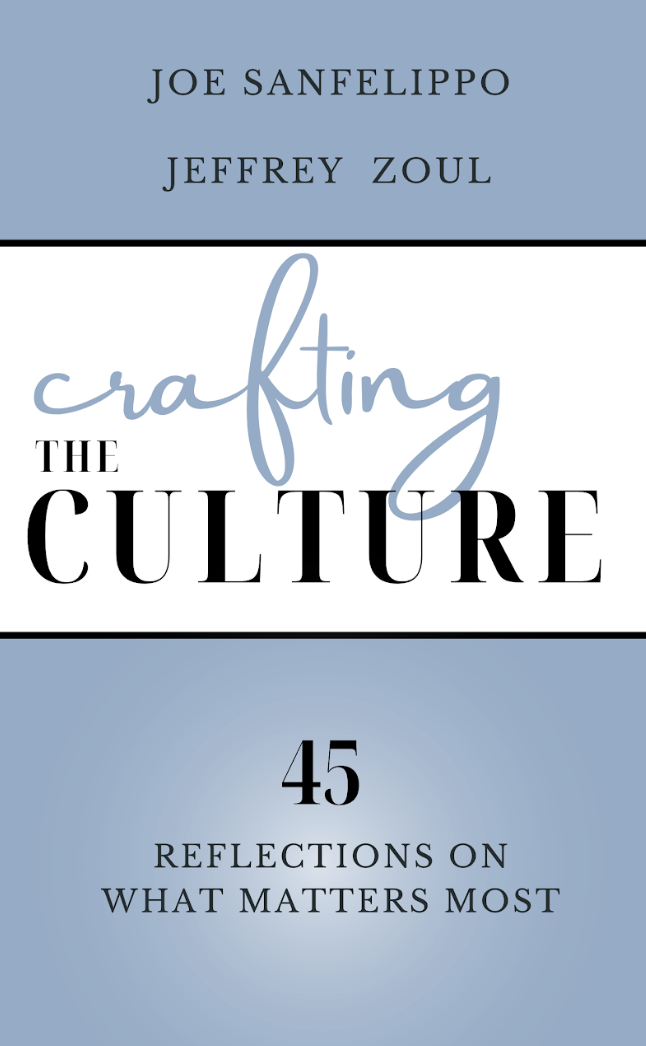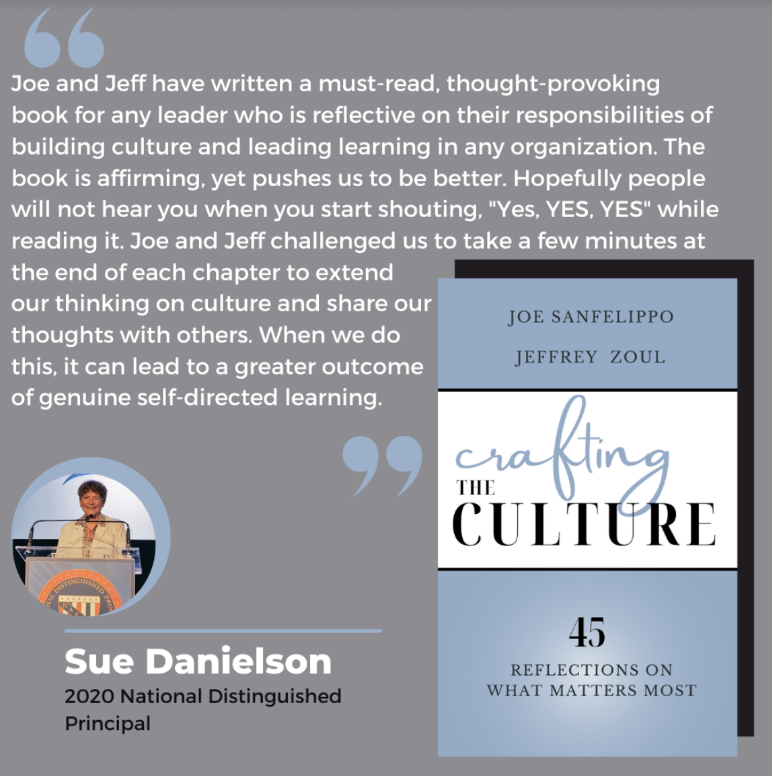CONNECTIONS: Cultures of Excellence
We are excited to announce the release of our newest book, Crafting the Culture: 45 Reflections on What Matters Most, by Joe Sanfelippo and Jeff Zoul. This week’s blog post comes to you from Joe and Jeff. We hope you enjoy their new book as well as all our books, available here! See more information below.
“Culture is what enables teams of people to defy the odds and achieve the remarkable.”
from the NfX Company Culture Manual
“Culture” and “Excellence” are two words that get tossed around so frequently that, at times, we fear they are in danger of becoming meaningless. Yet, we never tire of talking about school culture and how we can create cultures of excellence because we are convinced that (as stated above) it enables us to “defy the odds and achieve the remarkable.” Students and teachers can both perform at higher levels when working at schools with positive school cultures. Moreover, we have served in schools with almost identical characteristics and demographics that perform at distinctly different levels because of the school’s culture. We must not simply talk about excellence and culture; we must act intentionally to create and maintain a culture that is truly excellent, defining along the way not only what culture is, but also what excellence means to us and what it looks like in our day-to-day actions and interactions.
Culture includes the norms, attitudes, behaviors, beliefs, values, traditions, myths, and celebrations in place at any school. When working with educators on the topic of school culture, a good starting point is to examine shared values and explicitly create a list of core values that will guide subsequent beliefs and behaviors. We have seen this done successfully in any number of ways. We often start by suggesting that we all believe in excellence, obviously, and creating cultures of excellence. However, the word “excellence,” as we suggested, is meaningless unless we drill down a bit deeper. We often ask teachers and administrators to fill in a simple blank, describing in single words what they would like their school’s culture to be known for. Whenever we pose this rather simple task, within seconds each person is able to share several compelling words that most everyone in attendance agrees would be laudable culture descriptors. What are some words you would choose to describe the ideal culture you would like to be known for creating and working in?
Of course, it is not enough to simply brainstorm one-word culture values; we must turn these cultural values into cultural commitments. We must create action steps to achieve them, moving, perhaps, from things we believe to things we will do. Again, there are an infinite number of ways to create these statements. We continue to favor the idea of “We Will” statements and limiting these to five total. At one school we know of, educators spent a significant amount of time debating these and then wordsmithing the final five “Faculty Values Statements”, which ultimately included the following:
We Will promote and insist on a safe and orderly learning environment.
We Will design and deliver meaningful and relevant daily learning experiences.
We Will treat every person in our school community with dignity and respect.
We Will innovate through experimentation.
We Will recognize and celebrate our many successes.
What “We Will..” statements would you include as part of an excellent school culture? Excellent school cultures do not happen by chance; they happen by choice. In schools with excellent cultures, educators choose to create shared values. They choose to practice and celebrate cultural values. They choose to reflect on the culture and measure how they are doing in the eyes of staff, students, and parents. We recently wrote a new book, Crafting the Culture: 45 Reflections on What Matters Most in which we share 45 cultural words and phrases that we believe are part of a positive and productive culture. We share our own reflections on each daily phrase and ask readers to reflect on these, sharing their own thoughts via our hashtag #CraftingTheCulture We hope you will take a look and let us know what you think!
Thanks so much to Joe and Jeff for this post and for writing an amazing new book. Thanks to all educators reading this and for the amazing work you are doing during these challenging times.
As always, Teach and Lead with Passion...
DAILY INSPIRATION EDUCATOR
(Please let us know about an inspiring educator you think we should highlight in a future newsletter by completing this brief form!)
NEW BOOK!
Crafting the Culture: 45 Reflections on Matters Most by Joe Sanfelippo and Jeff Zoul
Nailing down a precise definition of culture can be tricky; at times, it seems as if culture is more a “feeling” than anything that can be quantified, measured, or seen. At the same time, the feeling about culture one gets when entering any school or classroom is palpable and it is relatively easy to distinguish between schools and classrooms with strong cultures from those with less productive cultures. Any leader interested in maximizing their influence on others and the performance of those they lead, whether first grade students, a group of teachers, or a team of business professionals, must be intentional about focusing on the culture they are trying to build and maintain.
This book is a collection of short, targeted insights into school culture from two school leaders who speak about culture in presentations throughout the country. Crafting the Culture contains daily reflections on culture that include a focus on specific words and phrases we often hear from audiences when describing their ideal cultures of excellence. These forty-five short, daily reflections will inspire you to think about how you are currently crafting the culture in your own setting–in particular, your classroom, school, or district.
Each daily reflection in this book includes a meaningful quote about culture–or the specific culture focus of the day–as well as thoughts from the authors on the day’s culture focus followed by reflective questions and action steps for readers to consider. By carving out a few minutes each day to read the quote, passage, and questions, readers can then reflect on these and consider how they might apply to their role and their setting. Begin Crafting the Culture in your own setting by reading these inspirational daily passages!
Crafting the Culture is available now via our website and Amazon. Click here for more information.
Check out what Principal Sue Danielson had to say about the book:
FEATURED BOOK!
L.E.A.R.N.E.R. Finding the True, Good, and Beautiful in Education by Marita Diffenbaugh
This book is for hope-givers who thrive when helping others develop their full potential. Marita Diffenbaugh identifies seven essential components to consider when providing education as a service to learners, along with a remix for measuring learning success. Throughout each chapter, look for the True, Good, and Beautiful, for when all three of these are present, we can be sure that students are learning how to learn, learning how to help others, and learning how to contribute to their communities and in our world. This book was written for difference makers like you who strive to create an education service that Listens, Empowers, Analyzes, provides Resources, understands students' Needs, designs Experiences, and offers caring Relationships.
We think you will really enjoy this book; let us know! Check out more here
CONNECTEDD’S TAKEAWAYS:
Thought for the Day: “You will become as small as your controlling desire; as great as your dominant aspiration." James Allen
Teaching Technique to Try: Analyzing Images: Use this strategy to guide students through a close analysis of an image. By following the steps in this image-analysis procedure, students develop awareness of historical context, develop critical thinking skills, enhance their observation and interpretive skills, and develop conceptual learning techniques. You can use this strategy with any visual media, including a piece of art, photograph, political cartoon, propaganda poster, or video clip. Check out this link from Facing History and Ourselves for a step-by-step process for using this technique.
Eyes On Culture: We believe that culture is a true difference-maker in any classroom, school, district, or organization. As a result, we focus much of the work we do on creating and maintaining positive and productive cultures. Culture Focus: Relationships and Expectations. High-performing schools with strong cultures are places in which adults serving in the school value relationships above all else, including relationships with the students they serve, of course, but also the relationships they have with each other, with parents, and with the entire school community. They are intentional about building such positive relationships, knowing it will not happen by accident. Relationship building is Job #1. Having said that, we cannot leave out the importance of also focusing on expectations. Excellent teachers begin Day 1 of the school year setting clear, firm, and lofty expectations for everyone in the classroom–starting with themselves, stating explicitly what they expect of themselves in terms of their words, actions, habits, work ethic, and character. They should also outline specifically what it is they expect of everyone else in the room in terms of their behavior and performance. If we do that on Day 1, we should then spend the next 179 days of the school year focusing on relationships–forging bonds with those we serve that are so strong and positive others will actually want to meet our expectations rather than merely doing so out of compliance. The same holds true for all relationships in the school community: We must start with both relationships and expectations. While it is true that any organization’s culture is based on relationships, it is also true that part of establishing strong and positive relationships is ensuring that everyone in the organization knows what is expected of them.
What are some other thoughts you have about building relationships and setting expectations? Please share your thoughts about a culture and gratitude via Twitter: @ConnectEDDBooks We would love to hear from you!



